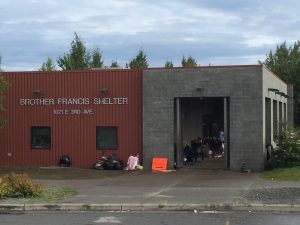
The Municipality of Anchorage is cracking down on homeless camps and serving 15-day eviction notices. Until very recently, the push was leading to massive overcrowding at Brother Francis Shelter. Dozens of people were sleeping outside of the building when it maxed out at 240 guests. Those numbers have dropped in the past week, though it’s unclear why. And coming from these short-term problems are some long-term solutions.
Ignatius Tyson stood outside of Brother Francis Shelter in Anchorage on a recent summer morning with his girlfriend, putting clothes into a black garbage bag. They just received the items from the shelter’s clothing room. Everything else they had was stolen from their campsite.
“One day we left there to go eat at a soup kitchen, came back and all our stuff was missing,” he said. “Everything –clothes, bikes, tents. Everything got taken from us.”
Tyson said he’s not sure who took it all because the other camps around theirs weren’t touched, and it felt horrible to have everything they owned taken away.
Being at the crowded shelter hasn’t been perfect either. Someone stole their blankets and shoes from outside Brother Francis the night before. But ultimately, Tyson said maybe leaving the camp was a good thing.
“I also look at that as a blessing, ’cause we’re out of the woods. We’re not drinking and drugging any more. We’re sobering up. We’re going to church more often.”
By going to church, Tyson said they’ve made new connections with people at an employment center, which is where he was heading as soon as he as stores his new clothes.
Lisa Aquino, the executive director of Catholic Social Services which runs the shelter, said it’s those connections that will help people out of homelessness. And though the shelter was bursting at the seams for most of the summer, she said even more connections were built as community organizations and the municipality pitched in to help with the problem.

“We’ve had just people stepping forward and working together and the problem solving has just been great,” she said.
AARP volunteers have helped sign seniors up for services, the municipality has put portable toilets outside BFS, and guests at the shelter are chipping in even more than normal to make sure everything runs smoothly.
BFS is also offering extra daytime services like laundry and showers, though they planned to do that even before the overcrowding started.
Aquino said she’s also seeing a shift in attitude among people at BFS toward getting permanent housing. She said people are getting excited and talking about the possibility of getting permanent housing. “I think the word is out there on the street so people are coming forward to ask for it.”
And that’s all part of the municipality’s complicated long-term plan: get people out of camps, out of shelters and into homes. Since the beginning of the year, outreach workers, municipal officials, police and others have been meeting weekly to talk about information collected from people at camps and shelters and ways to meet those individuals’ needs.
Nancy Burke, the municipality’s homeless services coordinator, says the meetings make it easier to juggle lots of complicated parts. “So it’s the whole making the rental money match up with when the units are available and the social services. It’s kind of three different worlds of connection that need to happen.”
When those connections do line up, she said it’s helpful to be able to find people quickly. That requires having folks go to shelters instead of moving from camp to camp.
Burke said she knows that closing the camps caused unexpected stress at shelters this summer, especially because many housing units are not available yet. But she says the municipality had to balance the needs of the entire community. It isn’t just about the needs of people living in the camps. Other community members worry about public safety in areas with lots of camps, like on the Chester Creek Trail.
“There are also homeowners…just adjacent to this area, that have a hard time when someone is camping very close. It’s threatening to them and people feel that just impacts their well-being.”
Burke said some of the threats are real and some are just perceptions. The camps can be violent places, but one can’t necessarily blame all petty crime on the people who live there.
“Our neighbors who are camping are literally just neighbors who don’t have a place to live. And if we had enough affordable housing in this community, then they would just be our neighbors.”
Burke said about 84 people who experienced homelessness were housed in the past year, and most of them were chronically homeless. There are about 400 people left to go.
Anne Hillman is the healthy communities editor at Alaska Public Media and a host of Hometown, Alaska. Reach her at ahillman@alaskapublic.org. Read more about Anne here.





